Dear readers, fellow gamers,
We are back with the second part on the DD focussed on Factions of the early 1920s Guomindang, sorry for having kept you waiting!
What sets us apart
We introduced the 1920 factions to you in the previous DD. These GMD factions are notably gameplay-wise differentiated by their views on a number of key topics of the era. They will oppose or ally one another around these themes, to make sure their views are promoted as party line.
We identified some 4 (and later 5) issues which you will discover below! We represented the two opposing poles on an axis, with the 1920 factions positioned on it according to their views on the subject.
Issue 1: Nationalism versus Foreign cooperation

Sun Yat-sen did set nationalism as one of the pillars for the Zhongguo Guomindang, the principle being embodied as one of the Three Principles of the People.
While the whole party agrees that the Chinese nation must regain its former splendour, the disagreement lies within the question of how to proceed.
The factions who think China is alone in this regard and can/should only rely on itself lean toward « Nationalism« . Those who are convinced that China needs to take the needed knowledge and assistance elsewhere (mostly from the West and Japan) lean toward « Foreign cooperation« .
Issue 2: Centralism versus Provincial autonomy

Gathering people under a unique and centralised banner has always been a key objectives of the Chinese imperial dynasties. However, given the size of China, the diversity of people and cultures inhabiting this land, they were constantly struggling with regional particularisms, striving for autonomy from the imperial capital.
This issue is still very much alive in the 1920s. The Qing dynasty collapsed in 1911, leading provinces to declare their independance. If the presidency of Yuan Shikai managed to maintain an illusion of national unity with Beijing as the centre of decisions, they soon bursted again into independence shortly after his attempt to crown himself emperor.
Sun’s views on the subject are simple: a centralised state is the only way to rule such a large country as China. The factions which adhere to this tenet lean toward « Centralism« . However, the 1910s in China saw anarchism becoming quite fashionable and bolstering ideas of autonomy and federalism. « Provincial autonomy » covers both the factions promoting federalism as an alternative way to govern the country and factions which are way more preocupied with the preservation of a particular provincial autonomy (warlords… Surprise!).
Issue 3: Revolution versus Traditions

Sun Yat-sen’s ideas, despite the fact they were inspired by the work of past reformists, are still nonetheless radical for a society like China in the 1920s. If Nationalism can appeal to most people, tired of seeing their country bullied by foreigners, Democracy is a very recent experiment in China: voting for representatives has been established by the Qings in the late 1900s at provincial level and the Republic only offered one presidential election and two parliamentary ones. Not every Chinese could vote to these. And let us not talk about people’s Welfare, a horrifying concept for landlords and bourgeois classes!
This axis depicts the take factions have on the implementation of Sun’s ideas: if this implementation is to be radical and rapid, they lean toward « Revolution« ; if they rather support a (very) gradual implementation (or even no implementation at all!), they are leaning toward the preservation of « Traditions« .
Issue 4: Civilian government versus Military authority

Since the fall of the Qing dynasty, warlord cliques have taken power at central level (Beiyang government) and regional level. Do you remember the definition of a warlord? A person who controls an army and a territory to sustain said army! The country is this very much ruled by militaries. Even the Guangzhou government which Sun Yat-sen first headed from 1917 to 1919 had him elected as « Generalissimo ». Not « President ».
The GMD does agree on preserving the Republican government form but not on who should be the custodians of the republican order: civilians or militaries? Unsurprisingly, those supporting a more civilian control over national affairs lean toward « Civilian government« . Those who think only the militaries can reunite the country and keep it united lean toward « Military authority« . Guess which side the warlords prefer?… Yes, you are correct!
Issue 5: Alliance with communism versus Anticommunism (later issue)

This fifth issue will not have any impact in 1920 and not before 1923. Why is that so? Because there is no Chinese Communist Party (CCP) before July 1921 and because the alliance with them was only endorsed in 1923 by Sun Yat-sen. However, in time, it will become THE one defining factor determining which side you take. Scholars even determines the acceptance or not of the communist alliance as what generated a left-wing and a right-wing in the Guomindang!
Do you think an alliance with communism is the only way forward for China? Then you lean toward « Alliance with communism« . Do you consider communists should not be trusted and accepted within the GMD? You are among those who preach « Anticommunism« !
Here below is a recap for all 1920s factions in terms of positioning along these five issues.

The 1920 faction system and you
You will probably wonder where you fit in this picture. Well, no worries, we have you covered! Before starting the game, after you created your character, you will be presented with a small political test. Through 10 questions, you will define your political positioning. This will determine your starting faction in 1920, right after you helped seizing Guangzhou. Should you skip this part, you will automatically end up in the « Independents » faction.
For each question, you will be asked whether you: completely agree, agree, do not know, disagree or completely disagree.
You will find here below a sample of questions to give you an idea of how the test look like. These are in French, so ready your dictionary! (or ask us on our Discord!).
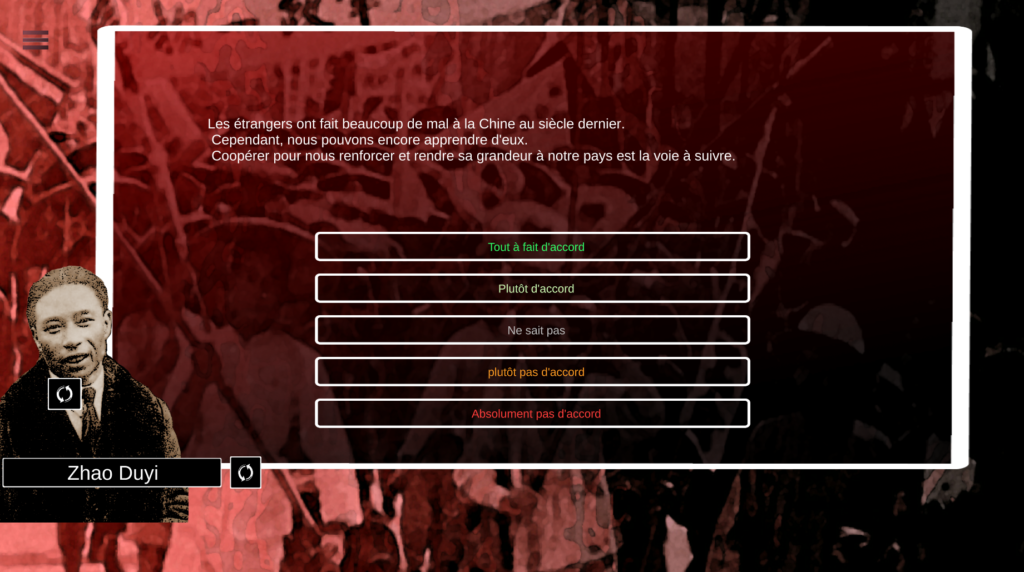
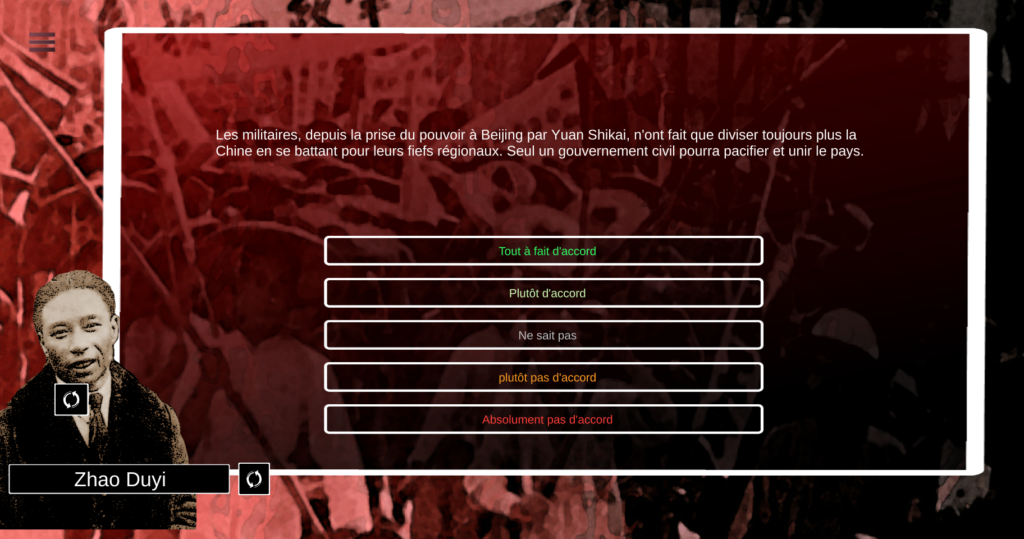
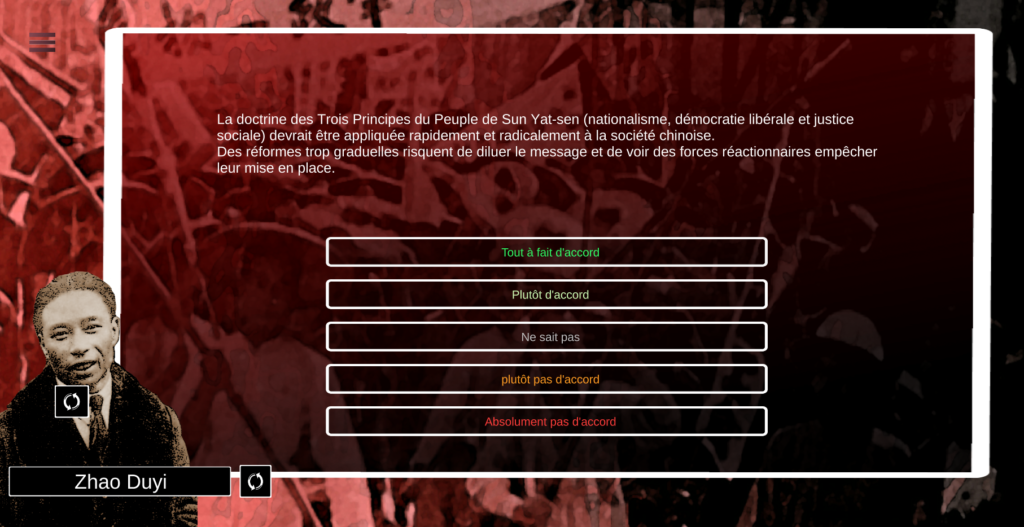
Once you have answered all 10 questions, the result appears: your starting faction will be introduced to you with a short text.
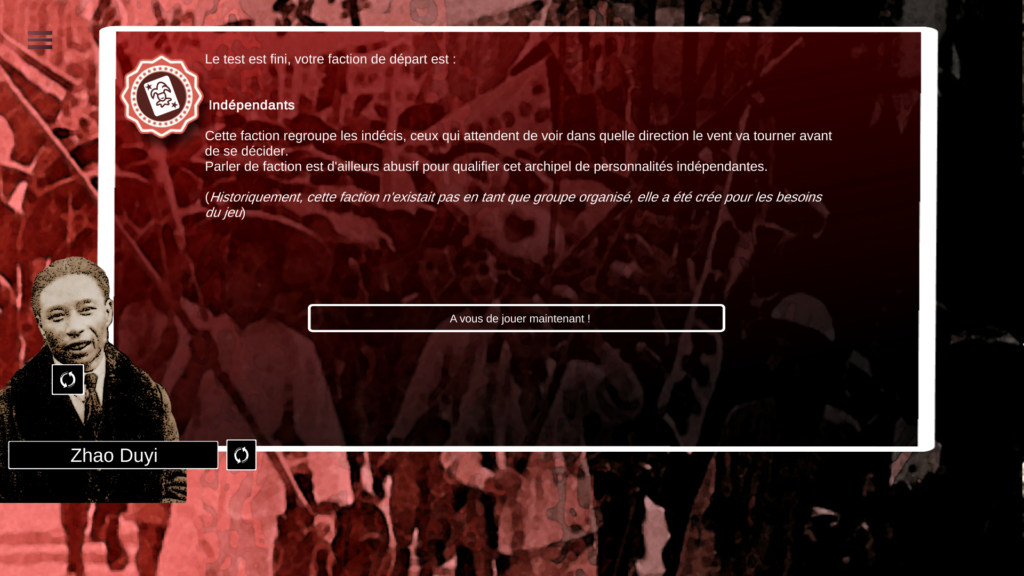
Only those who can adapt will survive
In time, you may realise that your starting faction does not match your vision anymore. Or cannot provide you with enough leverage for your to achieve your goals and ambitions. No worry, you will be able to change factions if you manage to convince the right persons to have you in their faction. We will come back in a future DD on how you can do this, using personal actions.
What we want you to know now is that you cannot however instantly switch from one end of the spectrum to the other. This has to be gradual or people would call you a turncoat!
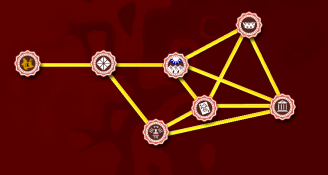
This is it for today, hope we had you interested on this bit of Rise of the White Sun. Stay tuned for more DDs!

the more i learn about this game the more i love it
one question if i may, hat happen when you take control of a faction ( if you can ) can you change the view of your faction ?
and if not too much to ask ofc, when do you think the game will be out ? 🙂
Dear Dos_g,
Taking the lead of a faction will indeed give you some freedom to alter its views but likely at the cost of some members. We are aiming for a playable demo in March-April 2021.
The RoWS team
im very happy to hear that, but the time will never get quick enough 🙂
oh that good news and can you join another faction as leader of your faction ? ( coalition ? ) and be the leader of it ?
or can we directly make our own faction ?
Hello Rows team 🙂
Its been a long time, i hope everyone is doing fine 🙂
just passing hoping the game will come out soon but no pressure take your time 🙂
( je suis francais si sa vous arrange plus de parlais en francais )
Dear Dos_g,
The team is well and safe! We have been silent for a while as attention shifted to another game prepared by the developer: Cauldrons of War: Stalingrad, which should come out very soon. We are however still working on development and hope to resume posting progress soon on this website.
If you are in for the freshest news, do join us on our Discord where we are active and always discussing (in English, French and any other language you can imagine) with players!
The RoWS team